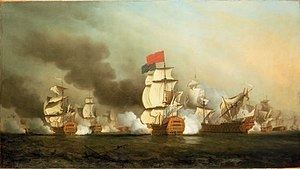Date 14 May 1747 | Result British victory | |
 | ||
14 ships of the line1 frigate1 sloop1 fireship 4 ships of the line8 frigates4 corvettes30 merchantmen 520 killed and wounded 4 ships of the line,4 frigates,4 corvettes,6 merchantmen captured,800 killed or wounded,3000 captured Similar Second Battle of Cape Fini, War of the Austrian Succession, Battle of Pfaffenhofen, Battle of Toulon, Battle of Hennersdorf | ||
First battle of cape finisterre 1747
The First Battle of Cape Finisterre (14 May 1747) saw 14 British ships of the line under Admiral George Anson attack a French 30-ship convoy commanded by Admiral de la Jonquière during the War of the Austrian Succession. The British captured 4 ships of the line, 2 frigates and 7 merchantmen, in a five-hour battle in the Atlantic Ocean off Cape Finisterre in northwest Spain. One French frigate, one French East India Company warship and the other merchantmen escaped.
Contents
- First battle of cape finisterre 1747
- Prelude
- Battle
- Aftermath
- Britain George Anson
- France de la Jonquire
- References
Prelude
France needed to keep shipping lanes open in order to maintain her overseas empire. To this end she assembled merchantmen into convoys protected by warships. Anson on Prince George and Rear-Admiral Sir Peter Warren on Devonshire had sailed from Plymouth on 9 April to intercept French shipping. When a large convoy was sighted Anson had made the signal to form line of battle. When Rear-Admiral Warren, suspecting the enemy to be merely manoeuvring to promote the escape of the convoy, bore down and communicated his opinion to the admiral, the latter threw out a signal for a general chase.
Battle
Centurion under a press of sail, was the first to come up with the rearmost French ship, which she attacked heavily and two other ships dropped astern to her support. The action became general when three more British ships, including Devonshire, came up. The French, though much inferior in numbers, fought till seven in the evening, when all but two of their ships were taken, as well as nine East India merchantmen. The French lost 700 men killed and wounded, and the British 520. Over £300,000 was found on board the ships of war, which were turned into British ships.
Aftermath
Following his victory, Anson was raised to the peerage. The French assembled another, much bigger, convoy which set sail in October; Hawke's defeat of this fleet in the Second Battle of Cape Finisterre put an end to French naval operations for the rest of the war. François de Grasse later the famous Comte was wounded and taken prisoner as he served on Le Gloire which was captured.
According to historian William Williamson, the battle was a "most severe blow to the French interests in America. Besides immense property taken, there were found on board … numerous articles designed for the Acadians and Indians" who continued to resist the British in Acadia/ Nova Scotia.
